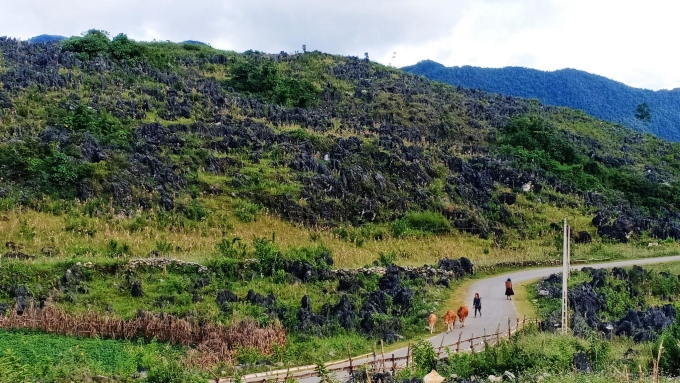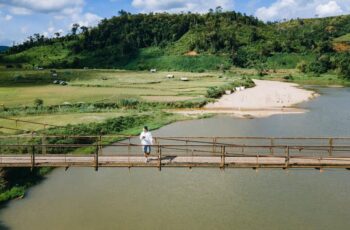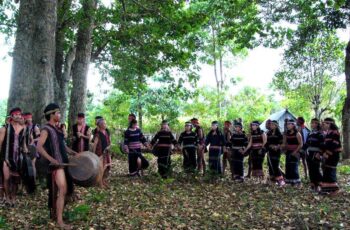Ad Blocker Detected
Our website is made possible by displaying online advertisements to our visitors. Please consider supporting us by disabling your ad blocker.
Vietnam has 10 provinces and cities bordering Laos and 10 pairs of international border gates, but tourism between border provinces has not yet developed to match its potential.
From Dien Bien to Kon Tum, Vietnam and Laos have 10 pairs of international border gates including Tay Trang – Sop Hun, Long Sap – Pa Hang, Na Meo – Nam Soi, Nam Can – Namkan, Cau Treo – Nam Phao, Cha Lo – Na Phao, La Lay – Lalay, Lao Bao – Dansavanh, Nam Giang – Dak Ta Ooc and Bo Y – Phoukeau. Stretching along the border of the two countries, there are a large number of nature reserves, national forests, caves, waterfalls, wild and majestic mountain and forest landscapes…
According to the assessment of more than 50 Vietnamese travel businesses from the South and North who are interested in border tours, this is a huge potential to develop caravan and overland tours products. road)… These tourism products not only attract tourists from the two countries, but also international visitors such as Thailand, Singapore, Myanmar, Australia, America and Europe.

Stone plateau in Tua Chua, Dien Bien. Photo: Duy Doanh
But in reality, the tourism potential of these border provinces has not been fully exploited or promoted into a key tour for many reasons.
“If I play the role of a tourist looking for typical products that connect the two countries, especially border tourism, it is difficult for me to find a satisfactory tour. Currently, there are only a few businesses organizing cheap tours from Hanoi, Da Nang to Pakse, Vientiane, Luang Prabang… The remaining businesses mainly build products according to customer requirements”, Mr. Nguyen Mr. Tuan, General Director of Ant Travel Co., Ltd., said.
In these areas, there are not many companies interested in the tourism potential of the two countries. Businesses from big cities are also not interested, and can only be counted on the fingers of one hand. The reason is that travel companies and tourists are still worried that administrative procedures to enter the border area will be difficult and inconsistent. Services such as restaurants, hotels, and accompanying services do not meet customer requirements. Infrastructure and transportation are poor, there is no connection between localities in border areas.
The above pairs of international border gates mostly only have routes from the border gate to the provincial center or connecting to national highways. Roads along the border with great potential for tourism development are almost impossible to exploit for tourism. For example, from the Na Meo password to Pu Hu nature reserve (Thanh Hoa), visitors can follow the “Tay Tien Journey” route to Moc Chau. But currently this route still has 5-7 km of dirt road in the forest and a suspension bridge that cannot be traveled by car. That hinders tourists from wanting to visit.

The top of Pha Din Pass, Dien Bien is also one of the beautiful destinations, loved by tourists to visit, check-in, and live virtually. Photo: Ngoc Ha
To overcome the above problems, Vietnam needs to simplify immigration procedures and mechanisms so that tourists do not feel embarrassed during their journey. According to Ms. Ta Thi Tu Uyen, Deputy Director of Product Development of Vietravel, border gates need to shorten procedure time and have priority flows for tourists, especially groups, to create favorable conditions. best for tourists.
Vietnam can easily build routes connecting not only the two countries Vietnam – Laos, but also reaching out to Southeast Asian countries. One of the tours attracting domestic and foreign tourists is Hue – Bangkok (Thailand); Vinh – Yangon (Myanmar); Dien Bien – Nayoidaw/Mandalay (Myanmar); Hanoi – Yangon… The distance between these locations is similar to Hanoi – Da Nang, or Hanoi – Ho Chi Minh City.
Along with investing in infrastructure, Vietnam also needs to take advantage of the strengths of 4.0 technology in tourism development. Mr. Luong Duy Doanh, Director of Fivestar Travel Company, said: “It is necessary to build a smart tourism system such as providing accurate information on local tourism websites, launching digital tourism maps, accommodation management system, free public wifi for guests at tourist attractions… This will make traveling to the border region easier and more convenient. Thanks to that, more and more tourists will come.”
Vietnam is still a traditional destination for Lao tourists. Laos is also a favorite destination for many Vietnamese people. In 2019, visitors traveling between the two countries reached over 1.2 million. Of which, Lao visitors to Vietnam reached more than 98,000 visits, and Vietnamese visitors to Laos reached more than 924,000 visits. Vietnam ranks third in sending visitors to Laos. In 2022, from the time the two countries open their borders, Vietnam will welcome nearly 47,000 Lao tourists. In the opposite direction, the number is 50,000, accounting for 28% of the total number of international visitors and the second market sending tourists to Laos.


